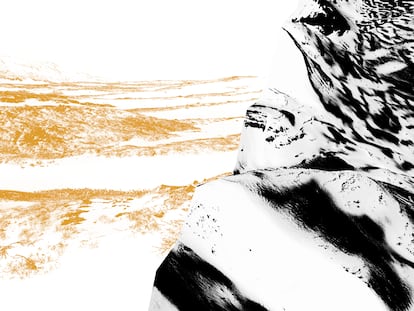Nikita Teryoshin, the photographer of the shameful business of war
Over the course of several years, the Russian journalist attended arms fairs around the world, creating a photobook. His publication offers a bizarre look at the disturbingly real, dark and prosperous business of war
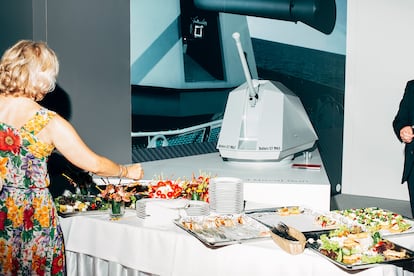
At the end of summer in 2016, as has been customary since 1993, the International Defense Industry Exhibition (MSPO), took place on the outskirts of Kielce, Poland. This is the largest arms fair in Central Europe. Over 600 companies from 30 countries displayed their products. Nearly 22,000 people gathered among tanks, machine guns, bazookas and the latest developments in the war industry, while they snacked on canapés, accompanied by glasses of wine or champagne.
Among the government delegations and vendors (the general public doesn’t have access to this type of fair) was the photojournalist Nikita Teryoshin. Born in St. Petersburg in 1986, this was the first time he had ever attended an event of this nature.
Impacted by the spectacle, between 2016 and 2023, he visited 80 international defense exhibitions in different parts of the world, giving shape to Nothing Personal: The Back Office of War. This photobook offers a bizarre glimpse into the disturbingly real, dark and prosperous business of war.
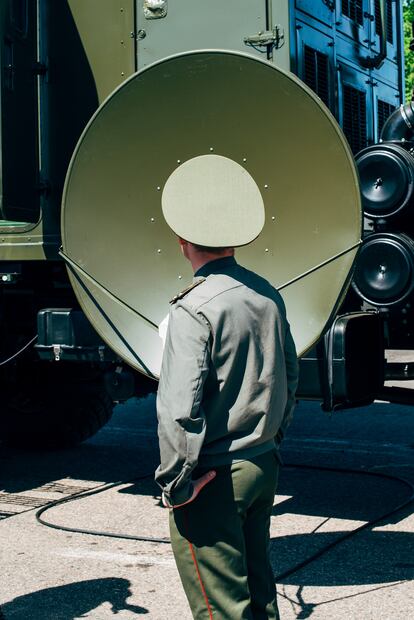
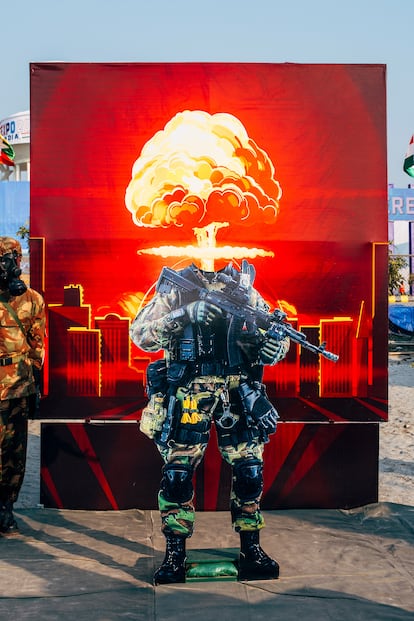
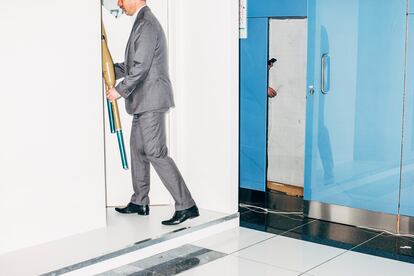
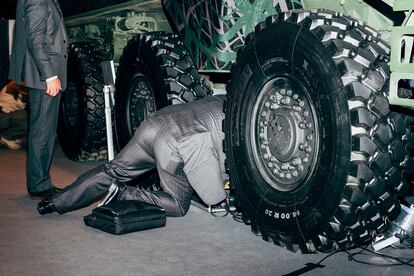
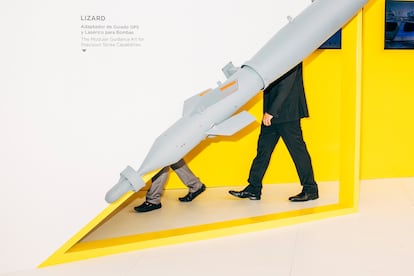

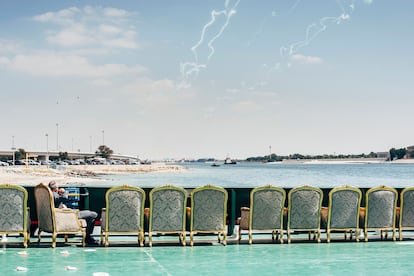
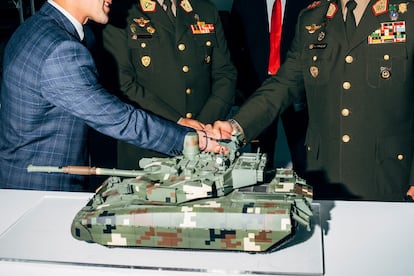
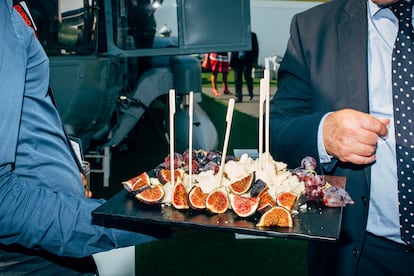

“I saw things that I could never have created in my imagination or thought would be possible,” the photographer says, during a video interview with EL PAÍS from his home in Berlin.
At a fair in Lucknow, India, there was a tank at the entrance to the men’s bathroom, while at the Indian Army stand, there was a photo montage of a headless soldier — wearing a Russian uniform and equipped with a Kalashnikov — with an atomic explosion emanating from his neck. And, in Abu Dhabi, on the occasion of the 25th anniversary of the International Defense Conference and Exhibition (IDEX), the author witnessed an unusual scene: “In one of the rooms, there was a cake more than [six feet] long. The decoration reproduced a strange militarized scene of land, sea and air, seasoned with edible ammunition. In the middle was an explosion (in frosting), surrounded by tanks and soldiers, fighters and warships. It was truly crazy,” the photographer recalls. “There came a moment when the guests were offered tiny plastic forks to eat the cake, which would end up looking like a real battlefield.”
“This industry is very cynical,” Terysohin notes. “A war against Yemen was taking place [600 miles] away and the Saudi coalition was bombing hospitals and schools. It was a really shameless scene. It looked like the shooting of a Hollywood movie.”
Through color saturation, the use of flash and forced angles, Teryoshin’s insightful and clear vision is able to frame scenes where the absurd goes hand-in-hand with tragedy. The photojournalist also dispenses with the human face. “I wanted to show the system, not the individuals. This [absence of faces] functioned as a metaphor for an industry that tries to go unnoticed.” Hence the photographer shows the opposite side of the battlefield, with all its mud and destruction: an over-the-top theme park for adults, where weapons shine among an immaculately-groomed public. Tanks, drones and thermal vision cameras are sold with the same nonchalance as vacuum cleaners at an appliance fair.

There’s no allusion to death at this type of event. Only the image of a single mannequin — which simulates a soldier whose leg is destroyed — alludes to the lethality of the merchandise. “[The mannequin] is used to teach soldiers and doctors what to do in case someone loses a leg,” explains Teryoshin. Interspersed among the images are the slogans used by the companies: “70 years defending peace,” emphasizes the company that distributes the Kalashnikovs. Lockheed Martin — the world’s largest arms manufacturer, which annually earns five times the United Nations budget for peacekeeping missions — doesn’t fall short: “Designing a better future,” its slogan asserts.
“This can only happen within a sector that’s governed by different rules than the others,” the photographer warns. “Within an industry that remains in a kind of bubble, where real feedback from society isn’t established. However, I fear that, even if the slogans were different, the import of weapons wouldn’t be affected.”
“Before the war in Ukraine began, [many European countries] exported weapons to Russia… and even at the beginning of the war, some companies continued to do so,” the photographer highlights. “If there’s no regulation, there’s no way that weapons won’t be sold to dictators. There’s no morality behind this industry. Business is business… hence the title of the series: Nothing Personal.”
The project is loaded with a good dose of humor, which “was a way to deal with the cynicism that all of this contains. If it weren’t for humor, I wouldn’t be able to believe in humanity anymore,” Teryoshin points out. “We’re very used to seeing images of war, but the question is: where do all these weapons come from? This is the part that’s rarely discussed in the media.”
Linda Åkerström, director of the Swedish Peace and Arbitration Society, highlights in a text included in the book: “The international arms trade remains less regulated than the banana trade.”

Although the book is very critical of the arms industry, the author is in favor of sending weapons to Ukraine. “We’re faced with a dictator: Putin. As a Russian, I still have my passport and consider it very necessary to support Ukraine. If it falls, other European countries will become the target of the Russian president,” he says.
“When I started the project, I didn’t think like that… but things have come very far. At this point, it’s necessary to protect democracy. And we need weapons. Which isn’t to say that I’ve stopped seeing the global arms trade system as a big problem. An escalation without an end.”
Nothing Personal: The Back Office of War. Nikita Teryoshin. Gost Books. 182 pages, 100 images. $60.
Sign up for our weekly newsletter to get more English-language news coverage from EL PAÍS USA Edition
Tu suscripción se está usando en otro dispositivo
¿Quieres añadir otro usuario a tu suscripción?
Si continúas leyendo en este dispositivo, no se podrá leer en el otro.
FlechaTu suscripción se está usando en otro dispositivo y solo puedes acceder a EL PAÍS desde un dispositivo a la vez.
Si quieres compartir tu cuenta, cambia tu suscripción a la modalidad Premium, así podrás añadir otro usuario. Cada uno accederá con su propia cuenta de email, lo que os permitirá personalizar vuestra experiencia en EL PAÍS.
¿Tienes una suscripción de empresa? Accede aquí para contratar más cuentas.
En el caso de no saber quién está usando tu cuenta, te recomendamos cambiar tu contraseña aquí.
Si decides continuar compartiendo tu cuenta, este mensaje se mostrará en tu dispositivo y en el de la otra persona que está usando tu cuenta de forma indefinida, afectando a tu experiencia de lectura. Puedes consultar aquí los términos y condiciones de la suscripción digital.
More information
Archived In
Últimas noticias
Welcome to the post-religion era: The idea of Christianity as the absolute truth has become obsolete
‘I thought you would like it’: The risky sexual practice popularized by TV shows and TikTok
The digitalization of tourism: ‘They promise experiences and gave us the worst possible one’
Mexican peso defies uncertainty with forecasts of a new period of stability in 2026
Most viewed
- Sinaloa Cartel war is taking its toll on Los Chapitos
- Oona Chaplin: ‘I told James Cameron that I was living in a treehouse and starting a permaculture project with a friend’
- Reinhard Genzel, Nobel laureate in physics: ‘One-minute videos will never give you the truth’
- Why the price of coffee has skyrocketed: from Brazilian plantations to specialty coffee houses
- Silver prices are going crazy: This is what’s fueling the rally


